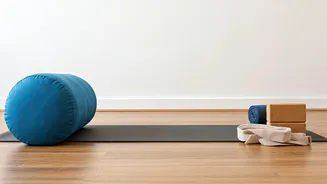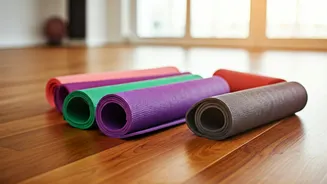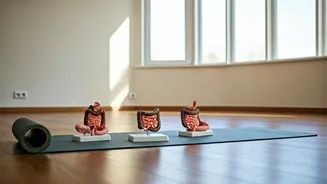Seated Forward Fold
The Seated Forward Fold, or Paschimottanasana, is often a go-to pose for many looking to soothe joint pain. To perform it, sit with your legs stretched
out in front of you. Keep your back straight. Inhale deeply and lift your arms up towards the ceiling. Then, gently exhale and bend forward from your hips, reaching toward your toes. If you're unable to touch your toes, just reach as far as is comfortable. This position provides a gentle stretch to the hamstrings and the lower back, both areas often involved in joint pain. By lengthening these muscles, the pose can help reduce tension and improve flexibility. Hold the pose for several breaths, focusing on your breath and relaxing into the stretch. As you hold this pose, your upper body gently folds towards your legs, creating a gentle compression. This can assist in releasing tension in the spine and improving overall flexibility. Always listen to your body, and modify the pose if needed. If you feel any sharp pain, come out of the pose immediately.
Child's Pose: Relaxation
Child's Pose, or Balasana, is a restorative yoga pose that is widely considered a fantastic way to relax and relieve stress, which can indirectly help joint pain. To do this pose, begin on your hands and knees. Then, bring your big toes together and spread your knees wide. Sit your hips back towards your heels. Slowly, lower your torso between your thighs, resting your forehead on the floor. Extend your arms forward along your head, or rest them alongside your body. Child's Pose gently stretches the hips, thighs, and ankles, while calming the mind. It also helps to release tension in the lower back and shoulders. Holding this pose allows you to focus on your breath and slow your heart rate, encouraging a sense of calm and relaxation. This pose is accessible to all levels and can be modified to suit individual needs. For example, if you cannot comfortably sit your hips on your heels, you can place a pillow or blanket between your thighs and calves for support.
Triangle Pose: Stretching
The Triangle Pose, or Trikonasana, is a standing posture that benefits the entire body and helps to lessen joint pain. To begin, stand with your feet about three to four feet apart, your right foot pointing outwards and your left foot slightly inward. Extend your arms to the sides at shoulder height. Then, shift your torso towards the right, reaching your right hand down towards your ankle or shin (wherever you can comfortably reach), while simultaneously lifting your left arm towards the ceiling. Keep your spine straight and your gaze towards the top hand or the floor. This pose stretches the sides of the body, opens the chest, and strengthens the legs. It also improves balance and stability. Remember to keep your core engaged throughout the pose to support your spine. If you're not quite able to reach your ankle, you can place your hand on your shin or use a block under your hand for support. Hold the pose for several breaths and repeat on the other side.
Cat-Cow: Spine Care
The Cat-Cow Pose, or Marjaryasana to Bitilasana, is a dynamic pose that enhances spine health, which may have a positive influence on joint pain. Begin on your hands and knees in a tabletop position. Ensure your hands are shoulder-width apart and your knees are hip-width apart. Inhale and drop your belly towards the floor, arching your back and lifting your chest and head, which is the Cow Pose. Exhale and round your spine towards the ceiling, tucking your chin to your chest, which is the Cat Pose. Flow between these two poses, coordinating your movements with your breath. This gentle movement increases spinal flexibility, massages the abdominal organs, and improves posture. As you move through the Cat-Cow sequence, pay attention to the sensations in your spine and core. The Cat-Cow Pose helps to release tension in the back and improve circulation, ultimately helping relieve joint pain.
Warrior Pose: Strength
The Warrior Pose, or Virabhadrasana, is a series of poses that build strength, stability, and focus. There are several variations, and each assists in building strength, which can help support joint health and mitigate pain. Start with Warrior I: step one foot forward and bend the front knee, keeping it over the ankle. Your back leg should be straight, with your heel planted firmly. Raise your arms overhead and look up. Warrior II: turn your torso sideways and open your arms parallel to the floor. Look towards your front hand. Warrior III: balance on one leg, extending your torso forward and lifting your other leg behind you, creating a 'T' shape with your body. These poses strengthen the legs, core, and back, and can improve balance and coordination. Focus on your breath, and listen to your body throughout the pose. By consistently practicing these poses, you can not only reduce joint pain but also enhance your overall physical health.
Bridge Pose: Support
The Bridge Pose, or Setu Bandhasana, is a restorative pose that helps improve joint health. To begin, lie on your back with your knees bent and your feet flat on the floor. Keep your feet hip-width apart. Place your arms alongside your body, palms facing down. Inhale and lift your hips off the floor, forming a bridge with your body. Engage your core and squeeze your glutes. Keep your thighs parallel. You can interlace your fingers under your body for added support. This pose stretches the chest, spine, and hips. It also strengthens the back muscles and improves circulation. Holding the Bridge Pose can help relieve stress and improve overall well-being, thus easing joint pain. Stay in the pose for several breaths, and then slowly lower your hips back to the floor. Repeat as desired, focusing on your breath and relaxing.



